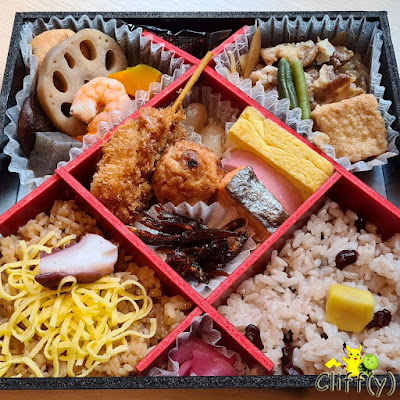JPN: Ekiben Tabi Bento (駅弁 旅弁当)
Not a single visit to Japan without 'ekiben'!
The Japanese writing is 旅の幕ノ内. Divided into nine sections, the second most popular ekiben shared some common items with Tabi No Nigiwai Gozen above. In addition to the two flavoured rice, there was a serving of white rice topped with umeboshi (Japanese pickled plum). The chicken meatballs were delightful, and so were the deep-fried triangular pockets filled with minced meat. To cap off the meal, the sweetened beans served as a delightful dessert.
A portmanteau of eki (lit. station) and bento (Japanese meal box), ekiben has long been an icon of Japanese culinary culture. I know the meal boxes are served at room temperature, but I'm always drawn to them, thanks in part to their exquisite presentation. My family bought some from Ekiben Tabi Bento situated within Kyoto station to savour them for lunch, not inside a train, but in the comfort of our hotel room.
Tabi No Nigiwai Gozen ¥1,100 (~S$9.90)
Taste: 7.5/10
The Japanese writing is 旅のにぎわい御膳. Topping the chart as the most popular ekiben from the store, the meal box was a visual delight divided into five sections, two of which were the carbohydrates: rice mixed with red beans and chestnut and soy-sauce flavoured rice topped with shredded eggs and a slice of octopus.
Kansai style dishes could be found in the middle, including takoyaki (Japanese octopus balls) and ikanago (Japanese sand lance simmered in soy sauce until dry). Additionally, there were a medley of stewed vegetables with shrimp on the top left-hand corner and a simmered beef dish on the top right-hand corner, the latter of which I found to be the most delectable.
Tabi No Makunouchi ¥950 (~S$8.55)
Taste: 7.5/10
Kaki No Ha Sushi (5 Mackerel) ¥700 (~S$2.45)
Taste: 5.5/10
The Japanese writing is 柿の葉寿司 (5鯖). A traditional specialty with its origin rooted in Nara, this variety of sushi is wrapped with kaki no ha (lit. persimmon leaf), which helps to preserve the fish longer due to its natural anti-bacterial properties. I enjoyed the leaf that added a distinctive herby flavour, but I found the fishy aroma of the lightly salted mackerel was rather strong.
Melon's Rating
Taste: 6/10
So, are you a fan of ekiben? Pika's advice: Take your time to browse through the wide array of options on display, and consider looking at the different kiosks around as well. Keep in mind that some shops may feature limited-edition ekiben from time to time.
Ekiben Tabi Bento
(駅弁 旅弁当)
Higashishiokoji Kamadono-cho
Shimogyo, Kyoto
Japan
(Daily: 11.00am - 11.00pm)
*Prices quoted are nett prices.
Have a nice meal,
Cliff(y)








Comments